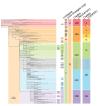Geographical and temporal distribution of SARS-CoV-2 clades in the WHO European Region, January to June 2020
- PMID: 32794443
- PMCID: PMC7427299
- DOI: 10.2807/1560-7917.ES.2020.25.32.2001410
Geographical and temporal distribution of SARS-CoV-2 clades in the WHO European Region, January to June 2020
Erratum in
-
Authors' correction for Euro Surveill. 2020;25(32).Euro Surveill. 2020 Aug;25(33):200820c. doi: 10.2807/1560-7917.ES.2020.25.33.200820c. Euro Surveill. 2020. PMID: 32820717 Free PMC article. No abstract available.
Abstract
We show the distribution of severe acute respiratory syndrome coronavirus-2 (SARS-CoV-2) genetic clades over time and between countries and outline potential genomic surveillance objectives. We applied three genomic nomenclature systems to all sequence data from the World Health Organization European Region available until 10 July 2020. We highlight the importance of real-time sequencing and data dissemination in a pandemic situation, compare the nomenclatures and lay a foundation for future European genomic surveillance of SARS-CoV-2.
Keywords: COVID-19; Europe; NGS; SARS-CoV-2; WGS; nomenclature; sequencing.
Conflict of interest statement
Figures



References
MeSH terms
Substances
Grants and funding
LinkOut - more resources
Full Text Sources
Other Literature Sources
Miscellaneous
